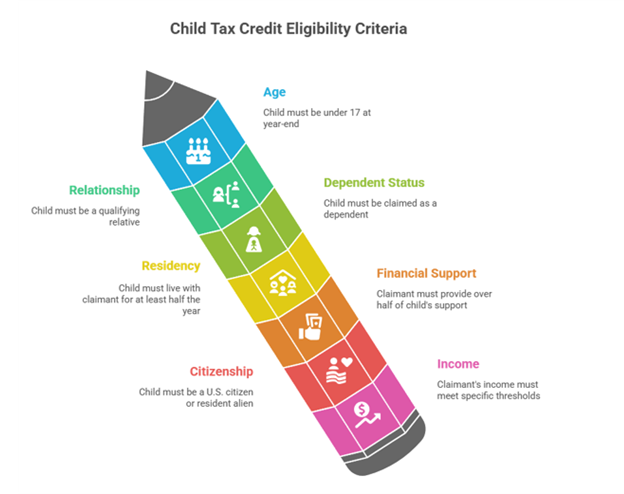Contributed by: AndyS, FreeTaxUSA Agent, Tax Pro

The One Big Beautiful Bill Act (OBBBA) passed this year and will introduce several tax law changes, affecting 2025 tax returns. One of these changes is the child tax credit (CTC). Many taxpayers with dependents find a lot of relief with the child tax credit on their tax return each year. This article will explore the changes, so you’ll know what to expect when filing your return.
What is the child tax credit?
The CTC increased from a maximum amount of $2,000 to a maximum of $2,200 per qualifying child. The amount has been increased from prior years to account for inflation. However, the amount of the credit you are eligible to claim may decrease based on income and how much tax due is calculated on your tax return.
How do I know if I can claim the child tax credit?
There are some basic requirements that your child must meet for them to be considered a qualifying child for the CTC. They need to pass the age, relationship, dependent status, residency, financial support, citizenship, and income tests for you to claim the credit.
- Age: Your child must be under the age of 17 at the end of the tax year. If your child turned 17 in 2025, they’re not a qualifying child.
- Relationship: The child must be your son, daughter, stepchild, eligible foster child, brother, sister, stepbrother, stepsister, half-brother, half-sister, or a descendant of one of these (for example, a grandchild, niece, or nephew).
- Dependent Status: You must be able to claim the child as a dependent on your tax return.
- Residency: The child lived with you for at least half of the year (with some exceptions).
- Financial Support: You are required to pay at least half of your child’s support throughout the year.
- Citizenship: The child must be a U.S. citizen, a U.S. resident alien, or a U.S. national and hold a valid Social Security number (SSN). New with the OBBBA, the taxpayer claiming the child must also hold a valid SSN (and their spouse, if filing jointly).
- Income: Taxpayers claiming the credit must meet certain income requirements. You may be eligible for the full credit amount if your modified adjusted gross income (MAGI) is $200,000 ($400,000 for married filing jointly) or less. However, if your income is more than the cap, it will reduce the credit $50 for every $1,000 you’ve earned over that amount until it’s eliminated completely.

My income is higher than the threshold. What will this look like?
If your filing status is married filing jointly and you have three dependents, your credit would be $6,600 ($2,200 x 3), if your MAGI is $400,000 or less. But let’s say your MAGI is $420,000. Since your MAGI is over the threshold by $20,000, your credit will be reduced by $1,000 ($50 x 20 = $1,000). You’ll have a CTC of $5,600 ($6,600 - $1,000) on your tax return.
My income is low, so my tax due calculated is less than the credit. Can I claim the full credit?
The CTC is a nonrefundable credit, which means it can be claimed only up to the amount of income tax owed and can’t result in a tax refund. Even if you have two qualifying children and are eligible for a $4,400 credit, if your tax due is $2,000, you can only claim up to $2,000 of the CTC.
However, the additional child tax credit (ACTC) is still in effect as in prior tax years. This is a refundable credit, which means it can result in a tax refund. The maximum amount of ACTC per qualifying child is $1,700. The credit amount is based on several factors, including your earned income and any part of the CTC not used.
Your earned income must be above $2,500 to qualify for the ACTC. Multiply your earned income by 15% to determine the amount you’re eligible to claim. If it’s more than the unused portion of your CTC, you can only use up to the unused portion. If it’s less, you can use the amount calculated by your income.
Returning to the example above, with only $2,000 of the CTC applied, you have $2,400 left unused. Let’s say your earned income is $20,000 for the year. Find 15% of that amount ($20,000 x 0.15), which is $3,000. Since $2,400 of the credit is unused, you can only receive $2,400 as a tax refund.
One important thing to remember is if you have the ACTC on your return, the IRS won’t start processing it until mid-February. As a result, you typically you won’t see your tax refund until early March.
FreeTaxUSA will calculate the CTC and/or ACTC automatically when you enter a qualifying dependent. You can view a PDF of your tax return to see Form 8812, which shows how your credits were calculated and how much you qualify for. It’s always a nice relief at tax time when you can claim the CTC, reducing your income tax and possibly resulting in a tax refund.
Also see:
https://community.freetaxusa.com/kb/articles/219-what-is-the-difference-between-a-refundable-and-nonrefundable-tax-credit?